Cleaning antique wood furniture can feel like a fun adventure, right? Start by dusting with a soft cloth—no one wants a layer of grime! Next, use gentle cleaners like oil soap. Remember to wipe with the grain. Is it damp, not soaking? Perfect! Don’t forget to check for hidden pests or damage while you clean. Keeping your treasures in a dry area makes a big difference. Curious about more tips to keep your furniture fabulous? Keep going!
Key Takeaways
- Identify the wood finish to select appropriate cleaning solutions and methods for your antique furniture.
- Dust the furniture with a soft, lint-free cloth, moving from top to bottom to prevent dirt from spreading.
- Use gentle cleaning solutions like oil soap, applying with a damp cloth that is not dripping to avoid excess moisture.
- Check for signs of damage or pest infestations during cleaning, looking for exit holes, frass, or blistering on the surface.
- Apply a suitable wood conditioner after cleaning to maintain the integrity and appearance of the antique finish.
Preparing to Clean Antique Wood Furniture
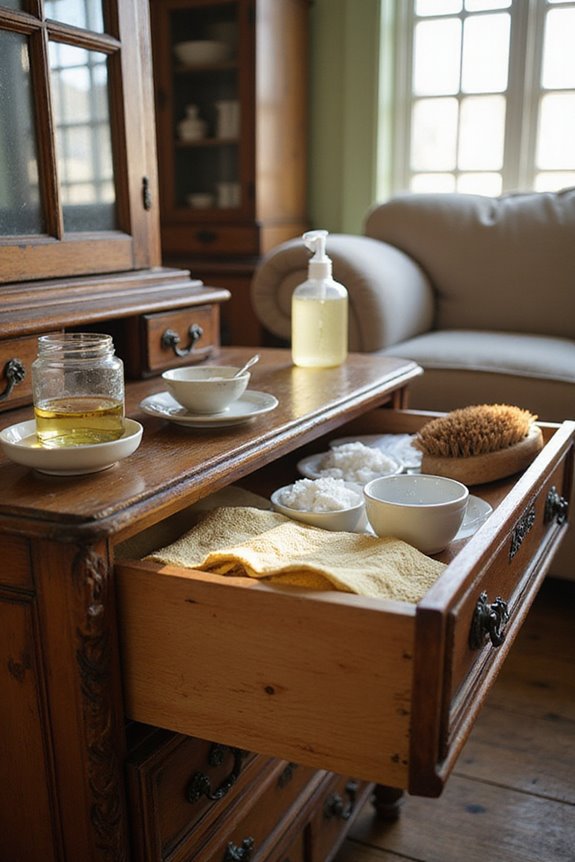
When you’re gearing up to clean your antique wood furniture, it’s important to start with the right mindset and tools! First, take a moment to identify your wood finish. Why’s that essential? Because it helps you choose the best cleaning methods! Next, inspect your furniture for any damage or wear—after all, you want to treat it with care.
Now, let’s talk workspace setup! Clear out any clutter to create a dust-free zone. Good lighting is key, so set up near a window if you can! Don’t forget your protective gear—gloves will keep your hands safe from chemicals. And before you immerse yourself, start dusting with a soft, lint-free cloth. Durable materials are essential in maintaining the longevity of your antique pieces. Ready to make that antique shine? Let’s do it!
Selecting Cleaning Solutions and Tools
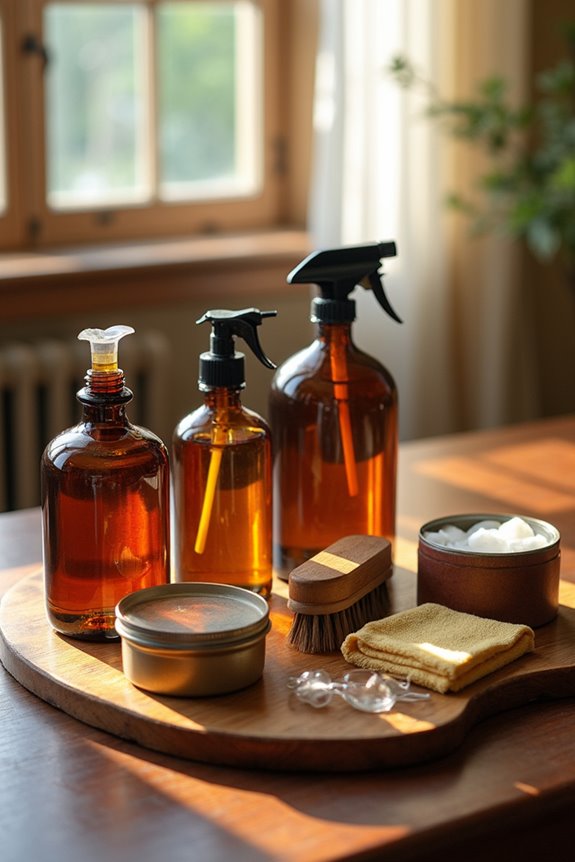
Selecting the right cleaning solutions and tools is like picking the perfect outfit—just as you wouldn’t wear a heavy coat to a summer picnic, you shouldn’t use harsh chemicals on your delicate antique wood furniture! Opt for gentle cleaning solutions like oil soap or odorless mineral spirits. These won’t damage the finish and can really make your furniture shine!
Now, let’s talk cleaning tools! Soft, lint-free cloths are a must for dusting without scratching. Got those intricate carvings? Cotton swabs can help you reach those tricky spots. And don’t forget your gloves! They’re key to keeping your skin safe from any cleaning solutions. Additionally, using high-quality fabrics can enhance the longevity of your furniture. Ready to choose your cleaning supplies? It’s an adventure waiting to happen!
Step-by-Step Cleaning Process
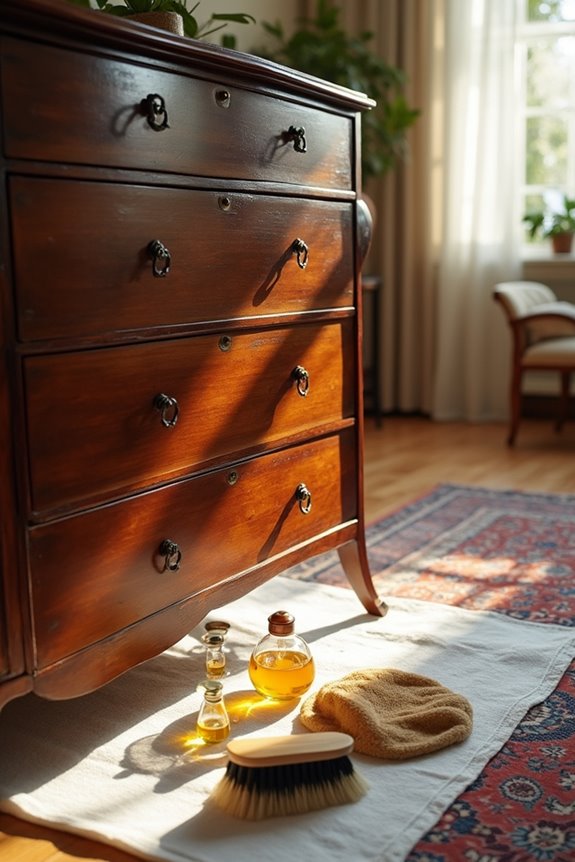
Now that you’ve got your cleaning supplies ready, it’s time to plunge into the actual cleaning process! Start by dusting the furniture to remove any loose particles—this prevents scratching the beautiful wood finish. You’ll want to work from the top down, not just because it’s efficient, but to avoid spreading dirt. Does that make sense?
When you’re wiping, always follow the grain! Use soft, lint-free cloths and apply gentle circular motions to lift away dirt. Remember, a cloth should be damp, not dripping. Have you checked the finish type? Different finishes require different cleaning techniques, so don’t skip that step! Additionally, taking proper care of your vintage leather sofas can help maintain their beauty and longevity. By following these steps, you’re not just cleaning; you’re helping with antique preservation! How cool is that?
Safety and Protective Measures
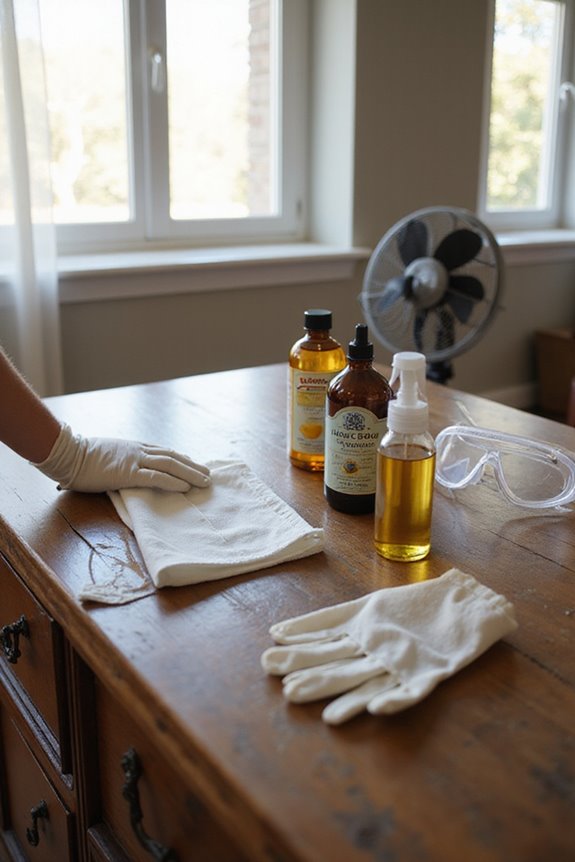
How can you keep yourself safe while cleaning that stunning antique wood furniture? First off, don’t skimp on protective gear! Slip on rubber gloves to guard against harsh chemicals and avoid potential skin irritation. You might also want to grab some goggles—nothing ruins a cleaning job faster than a splash to the eye, right?
And don’t forget an N-95 mask! It’ll help prevent you from inhaling harmful particles. When it comes to chemical safety, stick to mild wood cleaners and remember to dilute vinegar solutions. Always test any cleaner on a hidden area first. With these safety tips, you’ll keep yourself—and that beautiful furniture—safe and sound while preserving its charm for years to come! How exciting is that? Additionally, consider using dimmable options for your lighting needs, as they can create a warm ambiance while you work on your furniture restoration.
Handling Mildew and Mold
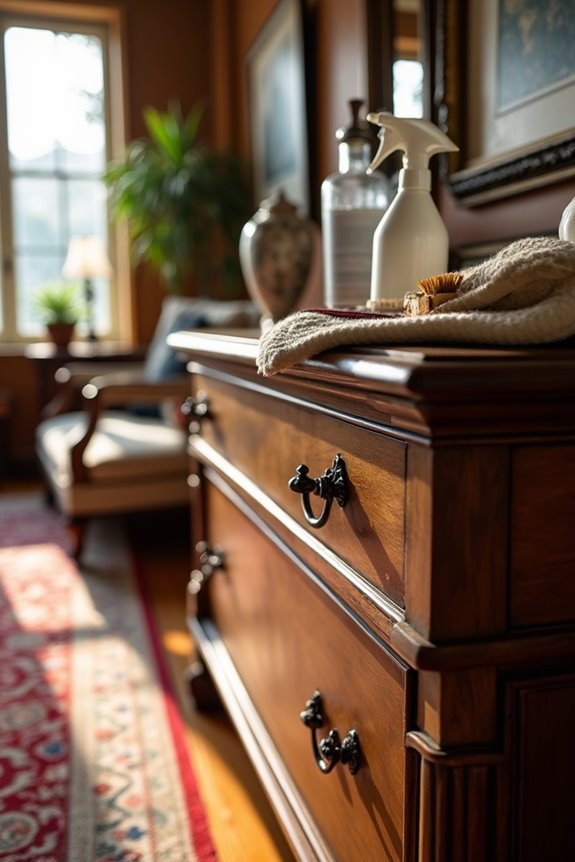
When it comes to antique wood furniture, tackling mildew and mold can feel a bit intimidating—especially if you’re not sure where to start! First, spot mildew identification by looking for those fuzzy or powdery spots. You may even catch that musty smell sneaking in. Yikes!
For cleaning, grab soft, lint-free cloths, distilled white vinegar, and rubber gloves. Mix a one-to-one vinegar and oil solution, then gently rub it on affected areas with a damp cloth—never apply directly! Additionally, it’s important to consider using machine washable fabrics for any coverings or drapery near your antique furniture to promote easy maintenance and cleanliness.
After cleaning, put your furniture in a dry, well-ventilated space. Mold prevention is key! Regular checks during damp seasons can save you time and effort. Who knew keeping your antique treasures could be this engaging? Let’s keep that mold away!
Preservation and Maintenance Tips
Keeping antique wood furniture looking its best can feel like a bit of a puzzle, can’t it? The secret lies in effective preservation techniques and regular maintenance schedules! Start by keeping your room’s temperature stable around 70°F and watch that humidity—35-45% is ideal in winter. Why not use sensors to keep track?
When cleaning, always start with a gentle dusting. And don’t you dare forget those coasters and placemats—protecting surfaces from scratches is key! Regularly check for pests and avoid heavy stacking, as that can damage joints.
Got a cloudy finish? Don’t hesitate to apply a soft wax polish. With these tips, you’re not just cleaning; you’re preserving history!
Replacement of Hardware
While you might think replacing hardware on your antique wood furniture is a challenging task, it can actually be a fun way to breathe new life into your beloved pieces! First, remove the old hardware carefully with screwdrivers and drills. Remember to keep that hardware safe in a baggie—losing it would be a shame!
When it comes to hardware types, you could simply swap out for similar styles or refinish existing pieces to save some cash. Got an odd size? Adjustable hardware can be your best friend!
Use precise installation techniques when drilling new holes. Measure and mark your spots to avoid any misalignment. Your antique deserves nothing less than perfection, right?
Importance of Proper Ventilation
Proper ventilation isn’t just a fancy term—it’s essential for keeping your antique wood furniture looking pristine. Have you ever noticed that musty smell lingering near your favorite pieces? Well, that’s a sign you need better airflow techniques! Open those windows regularly to let fresh air swoosh through, or use exhaust fans to clear out stale air.
Got some dampness after cleaning? Proper ventilation benefits your furniture by helping it dry quickly, which reduces the risk of mold. Plus, it keeps those pesky pollutants at bay, preserving your wood’s beautiful finish. So, are you ready to create a fresher environment for your cherished antiques? With a few simple steps, you can easily guarantee they remain in excellent condition!
Regular Dusting Techniques
Dusting antique wood furniture isn’t just about keeping things tidy; it’s a form of love! You’ll want to gather soft, lint-free cloths and a feather duster. Regular dusting is essential because, let’s face it, who likes a dusty table? Before you start, do a quick furniture inspection to check for any loose veneer or joints.
When you dust, use gentle circular motions to follow the wood grain. It’s almost like a little dance with your furniture! For intricate carvings, soft-bristled brushes work wonders. Remember, no chemicals or wet cloths! That finish is too precious to risk damage. So, are you ready to give your antique furniture the TLC it deserves? Let’s make it shine!
Monitoring for Damage and Pests
Keeping an eye on your antique wood furniture for damage and pests is like being a detective—exciting, isn’t it? Regular damage detection is key! Look for small exit holes or frass—those hints point to active infestations. Did you know that tapping the wood can reveal hidden tunnels? That’s a fun trick!
We all want to prevent pests from crashing our antique party, right? Always check for signs of live beetles or fresh frass when you clean. Have you noticed blisters or bubbles in the finish? That could be moisture from pests feasting away.
Frequently Asked Questions
How Often Should I Clean My Antique Wood Furniture?
You should establish a cleaning frequency based on your furniture’s condition. For maintenance tips, dust regularly, deep clean once or twice yearly, and adjust based on environmental factors and furniture finish to keep it looking great.
Can I Use Water Alone to Clean Antique Wood Furniture?
You can’t rely on water alone; it risks water damage. Instead, use safe cleaning methods with mild solutions. Always remember to wipe surfaces dry immediately to prevent issues like warping or mold formation on antique wood.
What Types of Wood Do Antiques Typically Come From?
When it comes to antiques, you’ve hit the nail on the head! They often feature woods like mahogany, known for its rich colors, and oak, celebrated for its durability. These materials stand the test of time beautifully.
Is It Safe to Use Commercial Cleaners on Antique Wood?
It isn’t safe to use commercial cleaners on antique wood; they can cause irreversible damage. Prioritizing antique wood preservation requires caution and choosing gentler cleaning solutions to maintain its integrity and value without harsh chemicals.
How Can I Tell if My Antique Furniture Needs Professional Cleaning?
If you notice signs of deterioration like chips, discoloration, or sticky surfaces, it’s time for a professional assessment. Don’t let further damage occur; seeking expert help can preserve your antique furniture’s beauty and integrity.





